Start using your Kanban board
TFS 2017 | TFS 2015 | TFS 2013
Your Kanban board turns your backlog into an interactive signboard, which provides a visual flow of work. As work progresses from idea to completion, you update the items on the board. Each column represents a work stage. Each card represents a backlog item, user story, or bug at that stage of work.
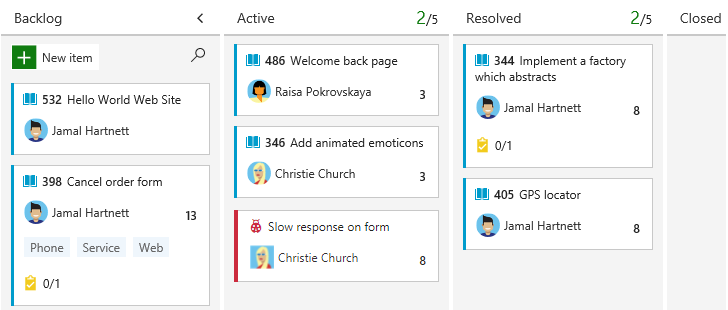
User stories and bugs correspond to types of work items. You use work items to share information, assign work to team members, update status, track dependencies, and more.
Boards are automatically created when you create a project or add a team. Each team has access to their own product and portfolio boards as described in About teams and Agile tools.
- You must connect to a project. If you don't have a project yet, create one.
- You must be added to a team or project.
- To add work items and exercise all board features, you must be granted Basic access or higher.
- To view or modify work items, your View work items in this node and Edit work items in this node permissions set to Allow. By default, the Contributors group has this permission set. To learn more, see Set permissions and access for work tracking.
- Users with Stakeholder access can't exercise these board features: add work items, drag-and-drop work items to update status, or update fields displayed on cards. They can add tasks and change task status.
If you have a project, you have a Kanban board. Each project defines a default team and set of boards for that team. You only need to add a Kanban board when you want to support a new team. When you add a team, you add many team assets. A team admin can configure the assets to support the way the team works. To add a set of Kanban boards to support a new team, see Add a team.
Each team's Kanban boards are associated with one or more work item types. The association depends on the process selected when the project was created, team configurations, and process customizations. The boards defined for each process are:
- Agile: Stories, Features, and Epics
- Scrum: Backlog items, Features, and Epics
- CMMI: Requirements, Features, and Epics
To customize your Kanban boards to add custom work item types, add portfolio backlogs, or other supported options, see On-premises XML process model.
备注
Both Kanban boards and Taskboards support visualizing the flow of work and monitoring metrics to optimize that flow. Kanban boards track requirements, are sprint-independent, and provide a cumulative flow chart for monitoring progress. Each sprint is associated with a Taskboard that supports tracking tasks defined for the sprint. You can monitor progress through capacity charts and the sprint burndown chart. For guidance on using the Taskboard, see Update and monitor your Taskboard.
Your Kanban board is one of two types of boards available to you. The other is the sprint Taskboard. Kanban boards track requirements, are sprint-independent, and provide a cumulative flow chart for monitoring progress. Each sprint is associated with a Taskboard that supports tracking tasks defined for the sprint. You can monitor progress through capacity charts and the sprint burndown chart. For guidance on using the Taskboard, see Update and monitor your Taskboard. For an overview of the features supported on each backlog and board, see Backlogs, boards, and plans.
To view your Kanban board, open your project from a web browser. Select Work > Backlogs > Stories, and then select Board.

If you don't see Work, your screen size might be reduced. Select the three dots (
 ) icon. Then select Work > Backlogs > Board.
) icon. Then select Work > Backlogs > Board.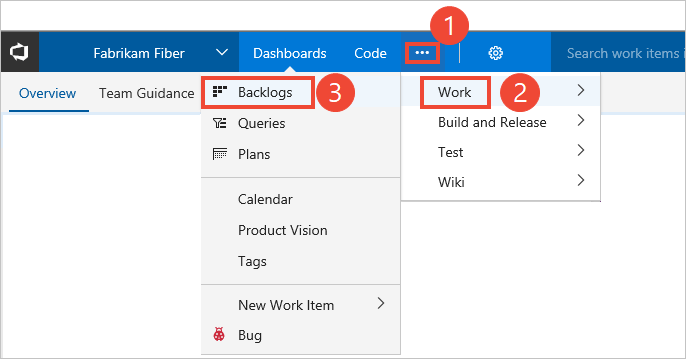
To select another team, open the project and team selector. Select a different team, or select the Browse option.

Your Kanban board appears.

To add a work item, select the ![]() plus sign, enter a title, and then press Enter.
plus sign, enter a title, and then press Enter.

The system automatically saves the work item with the title you entered. You can add as many work items you want by using this method.
To add details to any work item, select the title. Or, you can directly modify any field that displays. For example, you can reassign a work item by selecting Assigned To. For a description of each field, see Create your backlog, Add details and estimates.
备注
You can only assign work to a single user. If you need to assign work to more than one user, add a work item for each user and distinguish the work to be done by title and description. The Assigned To field only accepts user accounts that have been added to a project or team.
To customize the set of fields displayed on the card, see Customize cards.
As work completes in one stage, update the status of an item by dragging it to a downstream stage.
备注
Users assigned Stakeholder access aren't about to use the drag-and-drop feature to update status.
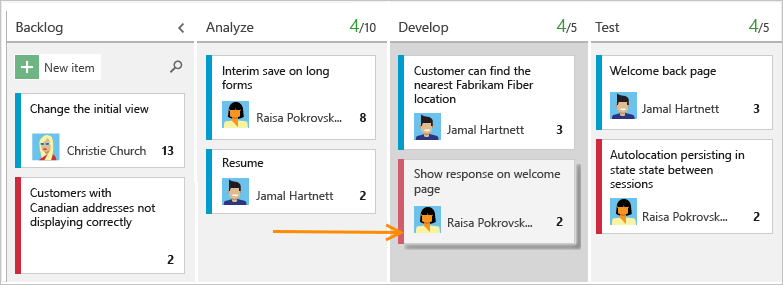
You can quickly update a field or reassign ownership directly from the board. If the field you want to update isn't showing, then customize the card to show it.

You can apply filters interactively to focus on a subset of work. For example, you can filter the board to focus on work assigned to at team member for a specific sprint. To start filtering, choose Filter ![]() . To learn more about applying filters, see Interactively filter your backlogs, boards, and plans.
. To learn more about applying filters, see Interactively filter your backlogs, boards, and plans.

For example, here we filter for all items assigned to Jamal and Raisa.
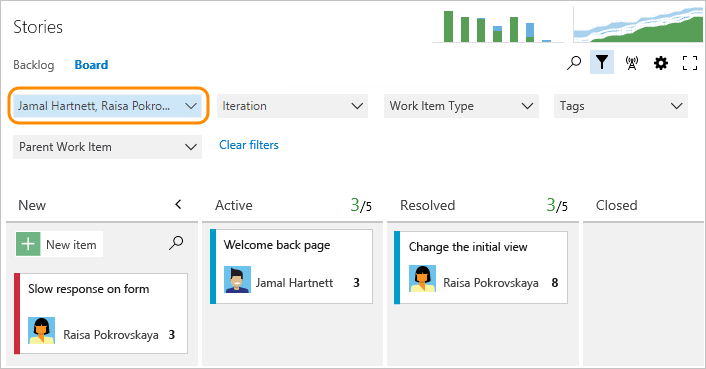
All members of a project can view and contribute to your Kanban board. To invite users to contribute, copy the URL of your Kanban board and email it to people you want to invite to your project.
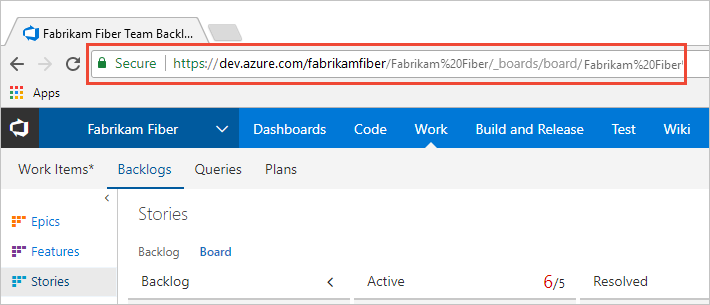
To add users to your project, see Add users to a project.
To get the full power of the Kanban board, configure it to map the flow of work and set WIP limits for your team. To configure the Kanban board, you must be added as a team administrator or be a member of the Project Administrators group. If you're the organization owner or creator of the project, then you have these permissions.